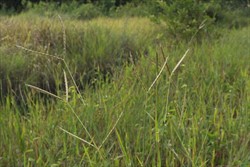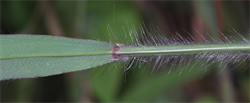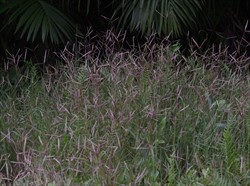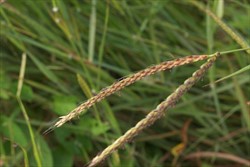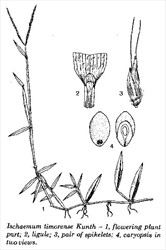Ischaemum timorense
Tropical Forages
Ischaemum timorense Kunth
Andropogon timorensis (Kunth) Steud.
Family: Poaceae (alt. Gramineae) subfamily: Panicoideae tribe: Andropogoneae subtribe: Ischaeminae.
A variable, spreading, erect, perennial (or annual), with ascending, scrambling, or stoloniferous growth habit, and fertile culms 15–60 (–100) cm tall. Stems rooting at the nodes; nodes silky. Leaf sheath keeled, 3–7 cm long, tight, hairy round the node, fringed towards the throat; ligule 2–4 mm long, a short fringed membrane, sometimes long ciliate; leaf-blade lanceolate to linear-lanceolate, 2–10 (–26) cm long and 3–15 mm wide, base obtuse or petiole-like, apex acuminate, glabrous, or with scattered soft hairs and prominent long, stiff, bulbous-based hairs towards the throat. Inflorescence terminal or axillary, well exserted, comprising 2 (–3) closely opposed racemes, each 2–10 (–15) cm long; spikelets inserted in pairs, one sessile, one pedicellate, alternately on one side of the triangular rachis; spikelets similar, 4–7 mm long, 2-flowered, green or tinged with purple, lower floret male, upper floret bisexual; lower glume with two acute lobes at the apex, upper glume with a short 2–3 mm long awn, upper lemma 2-lobed with a 10–17 mm long awn in the middle. Caryopsis ellipsoid, 1–2 mm long.
Similar species
I. timorense: constricted, petiole-like leaf base; wings on keel of lower glume of the sessile spikelet absent or <0.2 mm wide; apex of lower glume sharply bicuspidate; nodal hairs to 1.5 mm long, antrorse (pointing upwards); axillary inflorescences common.
I. ciliare: rounded leaf base; wings on keel of lower glume of the sessile spikelet prominent (0.2–0.7 mm wide); apex of lower glume comprising two rounded lobes; nodal hairs usually longer than 2 mm, spreading; axillary inflorescences uncommon.
English: centipede grass (also applied to Eremochloa ophiuroides); lucuntu grass; sarang buaya grass
Indian subcontinent: nilamunga hullu (India); රිලා තණ rila rat tana (Sri Lanka)
Latin America: capim centopéia (Brazil); ratana (Costa Rica); hierba ciempiés (Spanish)
Pacific: stalkleaf muraina grass (Hawaii); waidoi grass, waindoi grass (Fiji); tametamml (Palau); local batiki (Western Samoa)
Suriname: loekoentoegras (Dutch)
Native:
Asia: India; Indonesia; Federated States of Micronesia; Malaysia; Myanmar; Palau; Papua New Guinea; Sri Lanka; Taiwan; Thailand; Timor Leste; Vietnam
Naturalized:
Central & South America: Brazil; Costa Rica; Ecuador; French Guiana; Nicaragua; Panama; Suriname
Pacific: Fiji
Forage
I. timorense is a good species for permanent pasture, and is often found on heavily grazed communal land.
Environment
It is useful as a moderately shade tolerant cover under trees. It has been used to provide mulch in cropping systems, resulting in sweetcorn yields comparable to those achieved under irrigation.
Soil requirements
Grows on light to medium textured soils (not heavy clays), often of low fertility and with pH (4–) 4.5–5.5 (–7).
Moisture
Largely occurs in areas with average annual rainfall 800–2,000 mm, often with a pronounced dry season. Soils must be well-drained because it is intolerant of waterlogging. While it has some drought tolerance, it tends to dry off quickly under dry conditions and may behave more as an annual at the lower end of the rainfall range.
Temperature
Appears to be less tropical in its temperature demands than I. ciliare, being found up to 2,000 m asl at 7º S in Indonesia, and 1,300 m asl at 9.5º N in Costa Rica. Normally not grown in frosted areas, but unlikely to have any degree of frost tolerance.
Light
Grows in full sun and up to 50% shade.
Reproductive development
It is recorded as flowering from April–November in S Indonesia and flowering and fruiting from September to December in India.
Defoliation
Tolerates the heavy grazing found on communal grasslands. Can be cut if ungrazed.
Fire
Not usually relevant in high rainfall areas, but has the capacity to recover from fire from seed or stolons.
Guidelines for establishment and management of sown forages.
Establishment
Not generally planted as an improved pasture but highly valuable in communally grazed areas where it provides palatable feed, and ground cover against serious potential erosion.
However, if required, it can be propagated from seed or stolon cuttings. The high level of post-harvest dormancy in fresh seed starts to break down after about 6 months. Seedlings are vigorous. It is mostly established vegetatively to achieve rapid ground cover and weed suppression, and because seed production is unreliable. Cuttings can be broadcast onto the soil surface and disced in, or planted on a 30 cm grid. On the rare occasion seed is available, it can be sown at 3–6 kg/ha into a well prepared seedbed for successful establishment.
Fertilizer
Not normally applied but will respond to nitrogen (with other deficient nutrients).
Compatibility (with other species)
Frequently found with annual weeds and grazing-tolerant legumes under heavy grazing. Can suppress Chromolaena odorata seedlings.
Companion species
Grasses: Chrysopogon aciculatus
Legumes: Alysicarpus vaginalis, Grona heterophylla, G. triflora, Mimosa pudica, Stylosanthes humilis, S. hamata
Pests and diseases
Seed heads may be infected by head smut fungus (Tolyposporium bogoriense syn. Sporisorium flagellatum; Sporisorium ischaemicola syn. Sphacelotheca ischaemicola). It is an alternative host for dark-headed stem borer (Chilo polychrysa Lepidoptera: Pyralidae) and pink stem borer (Sesamia inferens Lepidoptera: Noctuidae).
Ability to spread
An opportunistic coloniser of disturbed areas, spreading by seed and stem pieces, and as a result, is common along roadsides, ditches, forest margins, around villages and as a weed of cultivation.
Weed potential
Like any widely adapted, easily established, stoloniferous grass, I. timorense may be a weed in arable land, e.g. in dry-land rice. It is a weed in onions, sugarcane, leguminous cover crops, rubber plantations, soybean and groundnut, and listed as an ‘environmental invasive’ by the Pacific Island Ecosystems at Risk (PIER) group.
Nutritive value
Palatability/acceptability
Well grazed by cattle, horses and sheep.
Toxicity
No reports of toxicity.
Feedipedia link
Dry matter
Production per head is usually limited by excessive stocking rates. Yields of up to 30 t/ha per year of fresh forage, roughly equivalent to wet season dry matter levels of 7.2 t/ha (6 week harvests) and 8.3 to/ha (4 week harvests) cited elsewhere.
Animal production
No information available.
2n = 20, 36. No known breeding or selection programs.
Stands can be rested and hand harvested, although smut infection may reduce quality. Seed is dormant for 6 months after harvest.
No specific information available.
- Naturalising palatable grass.
- Good ground cover.
Adapted to acid, low fertility soils.
Gilliland, H.B., Holttum, R.E. and Bor, N.L. (1971) Grasses of Malaya (A revised flora of Malaya Volume III). The Botanic Gardens, Singapore.
Ipor, I.B., Baki, B.B. and Chen, C.P. (1992) Ischaemum timorense Kunth. In: Mannetje, L.’t and Jones, R.M. (eds) Plant Resources of South-East Asia No. 4. Forages. Pudoc Scientific Publishers, Wageningen, the Netherlands. p. 148–149. edepot.wur.nl/327785
Soerjani, M., Kostermans, A.J.H.G. and Tjitrosoepomo, G. (1987) Weeds of Rice in Indonesia. Balai Pustaka, Bogor, Indonesia.
Sun, B. and Phillips, S.M. (2006) 205. Ischaemum Linnaeus, Sp. Pl. 2: 1049. 1753. Flora of China 22:609–613. bit.ly/3dEZpyH
None released.
None seported.
